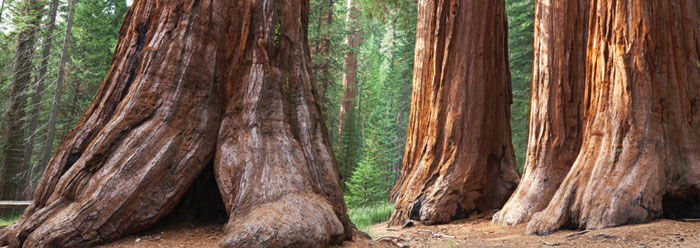Several species of trees live almost indefinitely. The giant sequoia trees of California are known to live over 3,000 years, discerned through tree ring dating. Under normal circumstances, woody trees add one ring per year. A ring typically consists of a light-colored growth portion and a dark-colored portion produced in a stabilization season. However, some trees do not produce annual rings at all, especially those in temperate or tropical regions.
Overlapping and correlating rings have been used to produce “chronologies” of past years. Linear sequences of rings are obtained by cross-matching tree ring patterns from living trees and those from older dead wood. A well-known study involved bristlecone pine trees in California’s White Mountains, but others have employed oak trees in south Germany and pine trees from Northern Ireland. Most chronologies only go back a few centuries, but a few give longer ages than the Bible seems to allow, supposedly up to 10,000 years or so.
Tree rings are more than a record of years. Year-to-year variation in the width of rings records information about the growth conditions in the particular year. Insect infestation clearly manifests itself, as does disease or fire damage. Each of these interrupts the normal growth cycle. Day length, amount of sunshine, water potential, nutrients, age of tree, temperature, rainfall, height above ground, and proximity to a branch all impact tree growth and tree ring production. By assuming the outer ring records the most recent year and that each ring signals one year, a researcher can determine the “date” of a particular ring simply by counting rings.
But how valid is the assumption of one ring per year in a climate where tree-growing conditions are variable? That very assumption is regularly put to the test by research foresters.1 They investigate how a tree grows, how and when it adds a new ring, effect of nutrients, rainfall, etc., over a range of related conditions.
Hundreds of individual trees have been observed over multi-year periods. Researchers monitor tree growth by attaching sensitive probes onto and into actively growing trees. Measurements are sometimes taken every fifteen minutes throughout the years of study! These are not mere ring-counting efforts on living and dead trees, but an observation of living trees and how they react to ambient conditions—how and when they make a ring.
It has been found that all trees, even slow-growing ones, respond dynamically to tiny environmental changes, even hourly changes in growing conditions. Scientists have observed that numerous “normal” conditions can produce an extra ring or no ring at all. Weather was fingered as the most “guilty” culprit. Unusual storms with abundant rainfall interspersed with dry periods can produce multiple rings, essentially one per major storm. Thus, the basic assumption of tree ring dating is demonstrably in error. Can we trust the overlapping calibration curves?
As it pertains to Flood model considerations, remember that the centuries immediately following the Flood witnessed the coming of the Ice Age. All trees growing on the continents were recently sprouted, actively growing trees. The still-warm oceans rapidly evaporated seawater, thus providing the raw material for major monsoonal-type storms. Earth was ravaged by frequent and wide-ranging atmospheric disturbances, dumping excessive snowfall in northern regions and rainfall to the south. If ever there was a time when multiple rings could develop in trees, this was it. Those centuries probably produced tree ring growth that was anything but annual.Thus, far from disproving biblical history, tree ring studies provide supportive and instructive information about true history.
Reference
- See Downes, G. 2010. Tree Rings, Dating and Changing Climates. DVD. Creation Ministries International.
* Dr. Morris is President of the Institute for Creation Research.
Cite this article: Morris, J. 2012. Tree Ring Dating. Acts & Facts. 41 (10): 15.










